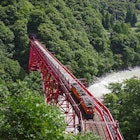
Japan's record-breaking bullet train can also run during earthquakes

Jul 7, 2020 • 2 min read
- placement: fullWidth
- path: articles/in-content-top
- possible size: [970, 250], [970, 90], [728, 90], [300, 250], [320, 50], [1, 1],
- targeting:
{ "url": "japan-n700s-bullet-train", "destination": "Japan", "continent": "Asia", "country": "Japan" }
Japan has unveiled a new bullet train that runs at record-breaking speeds and can even be used in rescue missions during earthquakes.
- placement: fullWidth
- path: articles/in-content-middle
- possible size: [970, 250], [970, 90], [728, 90], [300, 250], [320, 50], [1, 1],
- targeting:
{ "url": "japan-n700s-bullet-train", "destination": "Japan", "continent": "Asia", "country": "Japan" }
The new super-fast bullet train, or Shinkansen, can reach speeds of up to 360km per hour, that will be slowed down and capped at 285km per hour during service. But that's not the only impressive feature it has going for it. Besides being the fastest train in Japan, it operates using a 'rescue pack' lithium-ion battery that will allow it to continue to run, albeit at a lower speed, in the event of the overhead power supply being damaged or interrupted - a common occurrence during natural disasters like earthquakes.
It has a bunch of other cool features like a sensor that lights up when the train stops at stations to alert passengers to baggage still contained in the overhead compartment, therefore preventing them from leaving anything behind when they alight. Passengers will be able to rest more comfortably with newly-designed seats that recline even further than previous models and those needing serious shut-eye can enjoy a more peaceful slumber as the train has been installed with suspension features that reduce air resistance and noise.

- placement: native
- path: articles/in-content-native
- possible size: [f, l],
- targeting:
{ "url": "japan-n700s-bullet-train", "destination": "Japan", "continent": "Asia", "country": "Japan" }
Featuring a large 'nose' shape that allows for a faster performance, the train is called the N700S and will run between Tokyo Station in Tokyo and the Shin-Osaka Station in Osaka on the Tokaido Shinkansen Line, as well as on the Sanyo Shinkansen Line that runs all the way to Hakata Station in Kyūshū.
After 13 years in the making, the N700S undertook its maiden journey on 1 July after its launch intended to coincide with the now postponed Tokyo Olympics.
You might also like:
Travelling the Golden Route on Japan's Tokaido Shinkansen
New 'ultra rapid' train network could be part of Europe's post-pandemic recovery
China's most epic high-speed rail journeys
- placement: fullWidth
- path: articles/bottom
- possible size: [970, 250], [970, 90], [728, 90], [300, 250], [320, 50], [1, 1],
- targeting:
{ "url": "japan-n700s-bullet-train", "destination": "Japan", "continent": "Asia", "country": "Japan" }
Explore related stories







 Train TravelThe cost of a Japan Rail Pass has more than doubled - is it worth it?
Train TravelThe cost of a Japan Rail Pass has more than doubled - is it worth it?Oct 2, 2023 • 3 min read


